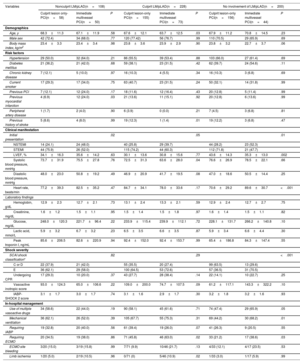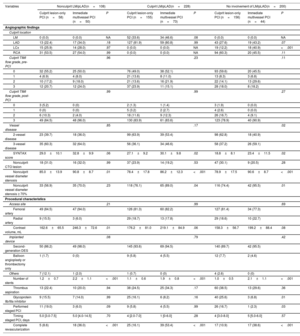
The association of revascularization strategy with clinical outcomes according to the ischemic territory of nonculprit lesion has not been documented in patients with acute myocardial infarction complicated by cardiogenic shock (AMI-CS). This study aimed to compare outcomes between culprit-only and immediate multivessel percutaneous coronary intervention (PCI) according to ischemic territory in patients with AMI-CS.
MethodsA total of 536 patients with AMI-CS and multivessel disease from the SMART-RESCUE registry were categorized according to ischemic territory (nonculprit left main/proximal left anterior descending artery [LM/pLAD] vs culprit LM/pLAD vs no LM/pLAD). The primary outcome was a patient-oriented composite endpoint (POCE) consisting of all-cause death, myocardial infarction, rehospitalization due to heart failure, or repeat revascularization at 1 year.
ResultsAmong the total population, 108 patients had nonculprit LM/pLAD, 228 patients had culprit LM/pLAD, and 200 patients had no LM/pLAD, with the risk of POCE being higher in patients with large ischemic territory lesions (53.6% vs 53.4% vs 39.6%; P = .02). Multivessel PCI was associated with a significantly lower risk of POCE compared with culprit-only PCI in patients with nonculprit LM/pLAD (40.7% vs 66.9%; HR, 0.52; 95%CI, 0.29-0.91; P=.02), but not in those with culprit LM/pLAD (P=.46) or no LM/pLAD (P=.47). A significant interaction existed between revascularization strategy and large nonculprit ischemic territory (P=.03).
ConclusionsLarge ischemic territory involvement was associated with worse clinical outcomes in patients with AMI-CS and multivessel disease. Immediate multivessel PCI might improve clinical outcomes in patients with a large nonculprit ischemic burden.
Keywords
Identify yourself
Not yet a subscriber to the journal?
Purchase access to the article
By purchasing the article, the PDF of the same can be downloaded
Price: 19,34 €
Phone for incidents
Monday to Friday from 9am to 6pm (GMT+1) except for the months of July and August, which will be from 9am to 3pm








